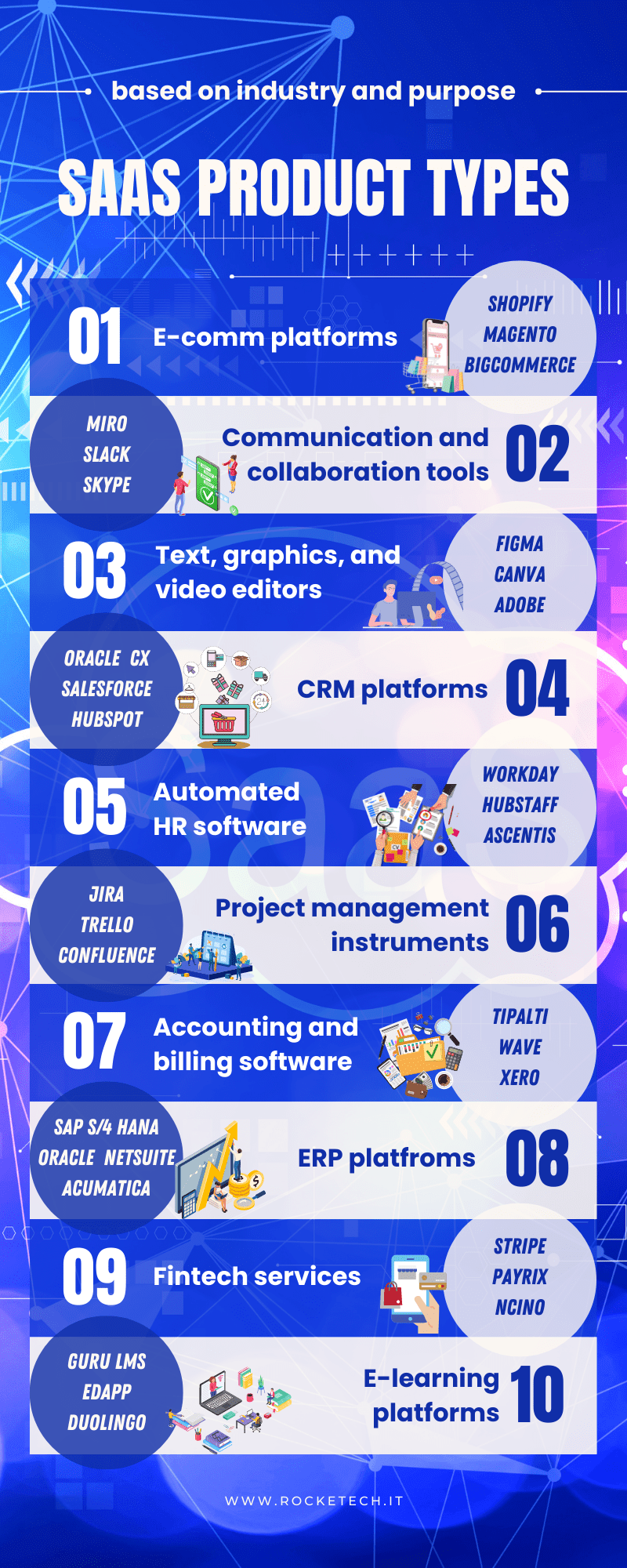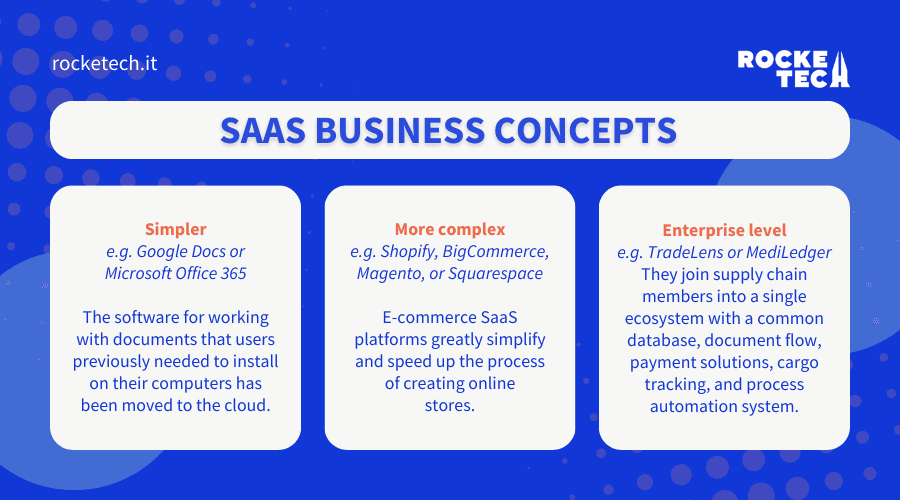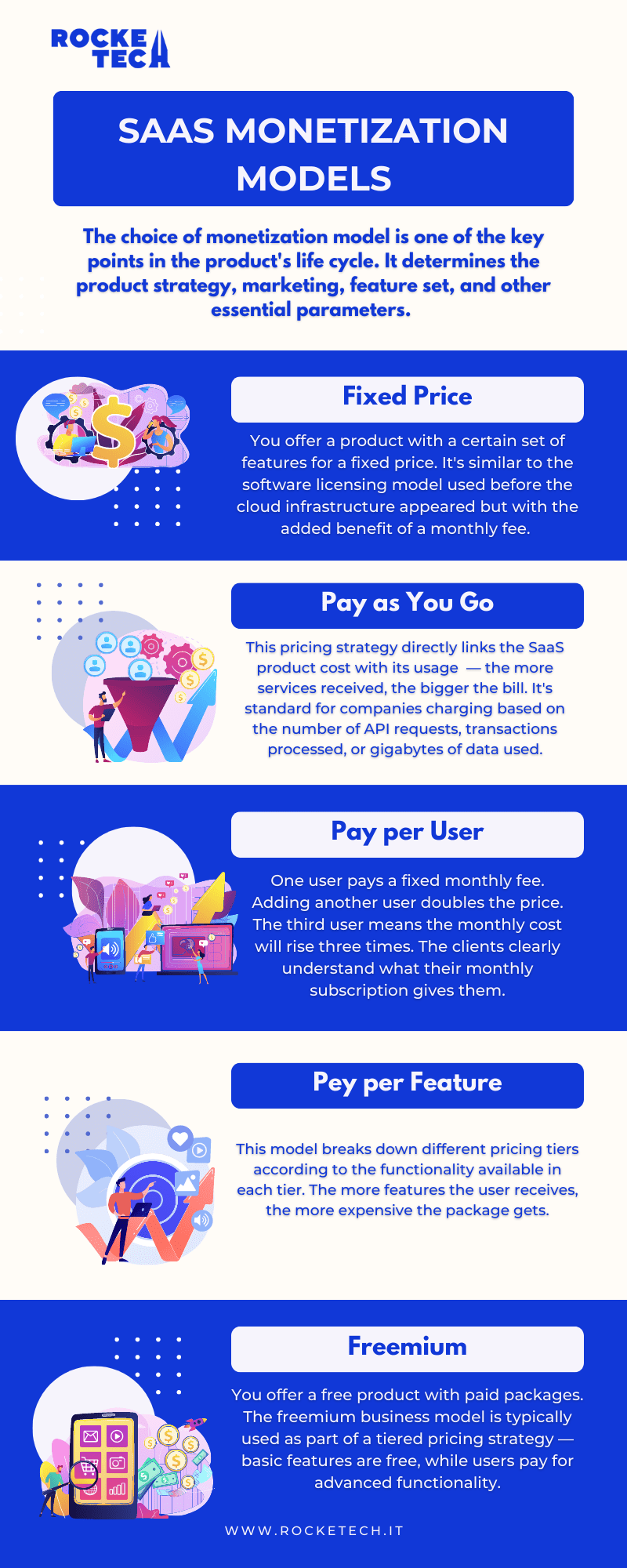SaaS stands for software as a service and refers to cloud-based software users can access through a website or a web app. Slack, Google Docs, Dropbox, and Shopify are just a few successful examples of SaaS platform development done right.
Is SaaS development still a solely big players’ prerogative? Can startups or local marketplaces enter this market? We summed up the most important points and explained how to build SaaS applications and solutions in this guide.

SaaS Development Overview: What is a SaaS Solution?
SaaS, or software as a service, refers to the use of the cloud to deliver licensed software that users can then pay for on a subscription basis. In other words, these are cloud solutions accessible through a web interface or a mobile app.
To work with such software, users don’t need to download and install anything on their computers or connect to an isolated corporate network. All you need to do is open it in an Internet browser. SaaS products can be anything from simpler office tools to complex enterprise-level software.
| SaaS is a business model for subscription software distribution. Users pay a set amount each week, month, or year and receive the service. |
SaaS Product Types
One of the reasons why the SaaS concept became so widespread is its versatility. Software-as-a-service products are now a big part of business ecosystems in nearly any field. Most often, they are grouped by industry or purpose. Here are the largest and most well-known types with examples.
- E-commerce platforms:
Powering online stores with everything from product listings to secure payments.
Examples: Shopify, BigCommerce. - Communication and collaboration tools:
Helping teams work together in real time, no matter where they are.
Examples: Slack, Microsoft Teams. - Text, graphics, and video editors:
Cloud-based solutions for content creation, design, and media production.
Examples: Canva, Adobe Creative Cloud. - CRM platforms:
Managing customer relationships, sales pipelines, and marketing automation. AI is playing an increasingly important role in CRM, shaping the way businesses interact with their customers. Know AI CRM to Know Your Customers research conducted by GoodFirms explores the latest trends and challenges in AI-powered CRM adoption. Examples: Salesforce, HubSpot. - Automated HR software:
Streamlining recruitment, payroll, and employee management.
Examples: BambooHR, Workday. - Project management tools:
Keeping teams organized with task tracking, timelines, and collaboration features.
Examples: Asana, Trello. - Accounting and billing software:
Automating financial operations like invoicing, expense tracking, and tax compliance.
Examples: QuickBooks, Xero. - ERP platforms:
Comprehensive business management tools that integrate finance, supply chain, and operations.
Examples: SAP, Oracle NetSuite. - Fintech services:
Cloud-based solutions for payments, lending, and financial analytics.
Examples: Stripe, PayPal. - E-learning platforms:
Enabling online education through course hosting, assessments, and interactive learning tools.
Examples: Coursera, Udemy.

Six Benefits of SaaS Solutions
SaaS cloud platforms steadily replace conventional software installed in on-premises infrastructure. We summed up six main reasons why businesses choose to develop SaaS applications.
#1 Easy to Set Up
SaaS applications are web-based. It means users don’t have to configure them in a complicated way. Companies also don’t need to purchase infrastructure resources to run these cloud-based services.
#2 Scalability
As the business expands, companies can easily scale the SaaS solutions. This allows them to handle growing workloads and accommodate more users. In the case of traditional software requiring on-premises infrastructure, scalability often becomes a challenge.
#3 Convenient Payment
The fee is included in the monthly (weekly or yearly, alternatively) operating costs and is easier for most companies to pay than an expensive software license. The subscription increases as the platform scales, naturally. However, the customer business doesn’t have to invest in additional infrastructure capacity.
#4 Instant Updates
Users benefit from SaaS software updates as soon as they are deployed. For comparison, when using conventional software, organizations have to purchase and install new versions to keep it up-to-date and access enhanced and additional features.
#5 Accessibility
Companies can use any SaaS application literally anytime and anywhere, as long as the Internet is available. It makes it easier to organize remote work, keep better control, and establish communication with stakeholders regardless of their physical location or time zones.
#6 Trial Versions and Basic Plans
Most SaaS products allow users to try them before making a decision. Instead of investing in an application that may not meet expectations blindly, users can test the features and see if they meet their needs.
How to Build a SaaS Platform in Five Steps
Some adventurous startupers try to find the best saas development platform and do it themselves, for example, with no code instruments. While it is a possible scenario, such products are rather temporary solutions — they lack flexibility and are not easy to scale. Let’s have a look at what happens if you go the way of custom development. Here’s our five-step guide on how to create the software as a service.
Step 1: Discovery
Whether you opt for a SaaS development platform or hire dedicated developers, successful projects start with a thought-through roadmap and good planning. To that end, startups use methods of product discovery or a project discovery phase. It revolves around three main aspects.
Your Business Idea
The first step towards creating your own SaaS solution is to understand exactly what you want to do, which problem, and how you want to solve it with cloud technology. In the case of SaaS application development, it’s usually making things easier to work with or moving software or your service to the cloud.
Successful business ideas aim to solve the problems of a specific target audience. In SaaS product development, cloud migration primarily simplifies a process (a website launch, project management, or document creation). After that, SaaS services develop ecosystems and develop additional functionality.

Market Research and Analytics
A comprehensive market study is essential to understand what your target customers need. Examine your competitors: design, features, marketing and advertising, pricing, and more. It will help you grasp how other startups implemented a similar idea, what worked well, and what can be improved to get a competitive advantage.
Conduct in-depth problem interviews with your potential users. It’s the quickest, relatively inexpensive, and most secure way to find the product-market fit. Combining the data from your customer research and analytics allows you to define the basic functionality.
Requirements and Documentation
A competent approach to documentation is the backbone of every successful project. Simply put, you need to create it so that managers always understand the business requirements of every release, developers plan every iteration and choose the right SaaS development tools, and QA engineers test the right parts of the software.
It is also the stage when the requirements management process starts. It involves identifying, documenting, analyzing, and prioritizing project goals. In the case of a third-party service provider (a SaaS developer, for instance), it also registers obligations and liabilities.
Step 2: Prototyping and Interface Design
The next step in developing SaaS solutions is creating a prototype. It should catch and convey the future product’s business logic schematically displayed. Although most likely you will make many changes at later development stages, a prototype can help define and readjust first features and, in some cases, already attract first investments.
Step 3: Software Development and Building an MVP
It’s the most significant part of any software development project. It’s complex and often broken down into shorter iterations. Each iteration should create an increment — value for the end user. The iterative process usually starts with creating a minimum viable product (MVP).
The MVP has limited functionality (sometimes, just one feature), which is yet ready for a market release. This way, you can collect valuable feedback from the first users and plan and develop further features accordingly.
Step 4: QA and Testing
QA stands for quality assurance. QA engineers don’t just test software for bugs but maintain product standards in the long run. Their main task is to prevent software defects and, as a result, ensure the high quality of the development process and its outcome.
Many startups with limited resources try to save up on the QA stage and required specialists. In reality, poorly organized QA processes lead to much bigger financial losses — from hiring specialists to fix badly written code to losing customers due to a poorly functioning product.
Step 5: Scaling and Maintenance
Development is never over with the full-product release. Successful ideas evolve, and profitable businesses expand. There are many strategies for scaling digital products. But it’s important to remember that (like with any other software type) for SaaS, programming doesn’t stop when you make it available in the market.
For example, Salesforce developed machine learning, AI-based products to upsell them to existing customers, grew into new areas like social media marketing and advertising, and became a global SaaS application development platform.
Building a SaaS Product: Monetization Models
Similarly to other software types, there are several ways to monetize a SaaS project. The choice of a pricing model depends on several factors, including target audience, industry, number of features, and complexity. Naturally, founders need to think this part through very carefully to return the investment in the cost of developing a SaaS platform and start generating profits.

Final Thoughts on SaaS App Development
Although the idea of creating your own cloud-based product may seem unrealistic, more startups nowadays launch successful services in niche markets. However, there’s a catch. If your budget doesn’t include hiring an in-house tech team, you’ll need trustworthy SaaS platform developers to support your business throughout the entire journey.
At Rocketech, we have hands-on experience with the SaaS development process from ideation to product launch and scaling. We offer our clients not only full-cycle software development services but also provide them with business advice and market expertise.
Let’s discuss its business potential.